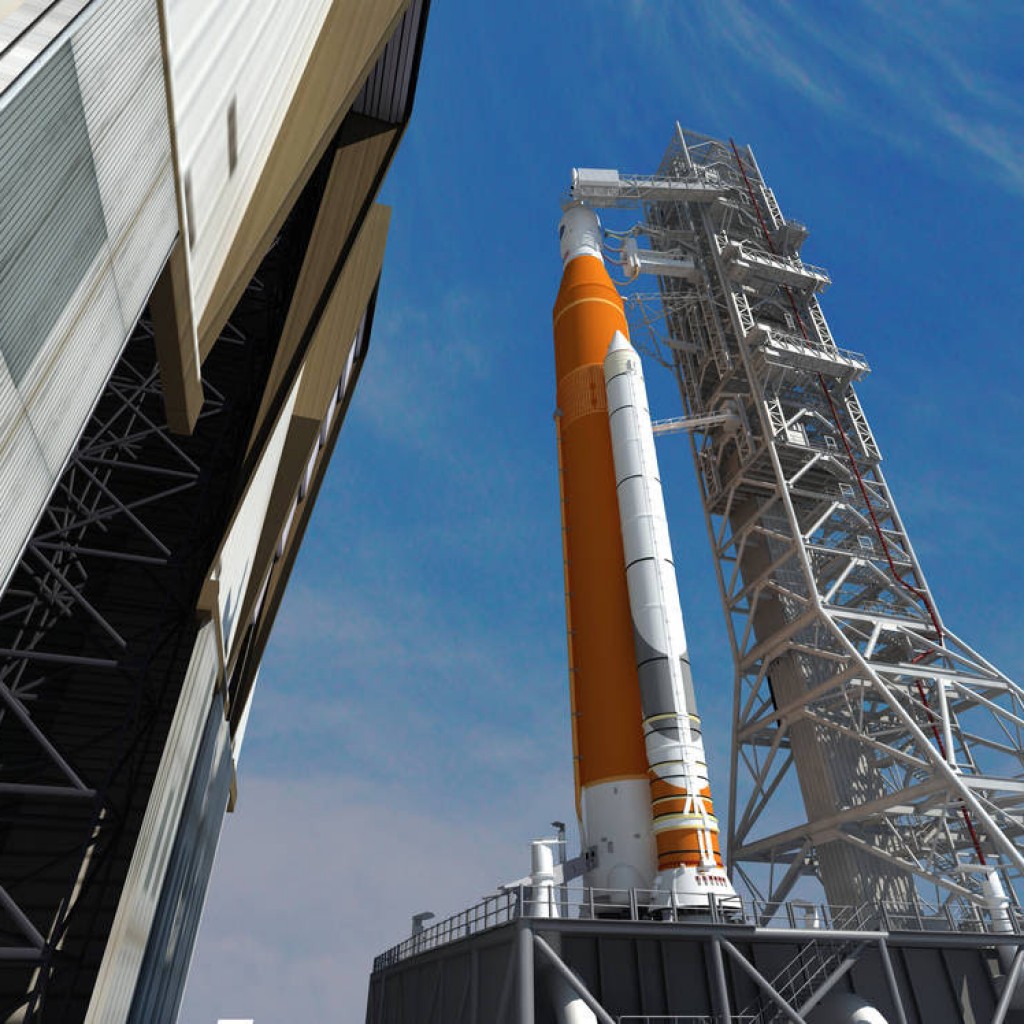
NASA’s plans and preparation for Kennedy Space Center to handle rocket launches to Mars are on track with overhauls of a key launch pad, the iconic Vehicle Assembly Building, a new mobile launcher and other major improvements, the agency has said.
As the nation’s premier launch complex prepares to host private company space launches in the next few years, it also is being upgraded to handle the world’s most powerful rocket, NASA’s planned Space Launch System, and other assorted space hardware needed for the agency’s major long-term mission to Mars.
A NASA report from last week concludes that a comprehensive review of plans for facilities finds KSC is on track for the first SLS launch in 2018. It will also support future manned and robotic missions with that rocket and its spacecraft, the Orion.
When the new rocket is built, NASA can’t just haul it out to Kennedy Space Center, stand it up and launch it. Assembly, preparation and launch infrastructure all must be redesigned and rebuilt for it. The new NASA report indicates that’s all on track.
“Each and every day we’re making steady progress toward it,” Mike Bolger, manager of NASA’s Ground Systems Development and Operations Program at KSC, told FloridaPolitics.com. “Here at Kennedy the excitement is starting to build. We’re now less than two years away from having the (SLS rocket and Orion spacecraft) hardware show up. We’ve been out to the factory in New Orleans, seeing the stuff coming together. It’s an enormous rocket, which is really exciting.”
NASA announced the on-track findings of the new report as a major milestone after months of engineering and aerospace experts’ review of KSC designs, and construction and operation plans. It’s essentially a thumbs up from NASA headquarters that Kennedy’s plans, cost estimates, timetables and construction are all credible to make the center ready for the 2018 test launch of the SLS to carry an unmanned Orion into space.
“NASA is developing and modernizing the ground systems at Kennedy to safely integrate Orion with SLS, move the vehicle to the pad, and successfully launch it into space,” Bill Hill, deputy associate administrator of NASA’s Exploration Systems Development Division stated in a news release announcing the milestone.
Unlike NASA’s last major program, the space shuttle, the SLS and its spacecraft, the Orion, will not be launched with any frequency. The shuttle went up several times a year, while the Orion might go up only twice in the next five years, and at best annually for the next five. So the vast majority of the 7,000-plus jobs lost on Florida’s Space Coast when the Shuttle program ended are not being replicated for the Orion.
But NASA is spending about $2 billion for the upgrades at Kennedy, and hundreds of jobs are being created.
Chief among them:
- Overhaul of Launch Complex 39B, which previously launched Apollo/Saturn V rockets and space shuttle missions. The space shuttle towers have been removed. Two 500-foot-tall lightning towers have been erected. The brick flame trench is being replaced with a new flame deflector to handle the 9.2 million pounds of thrust the rocket could have at liftoff.
- The 25-foot-tall Vehicle Assembly Building, which has prepared rockets for launches since 1966, has one of its four bays being remodeled to service the 324-foot-tall SLS rocket and Orion, with up to 10 movable platforms to provide access to various parts of the rocket. [One day, with additional stages and components it could be 400 feet tall but that will require future changes to the VAB.]
- NASA has constructed a mobile launch tower, weighing 9 million pounds, that will be mated to the rocket inside the VAB and rolled out to Launch Complex 39B. Now NASA is fabricating multiple umbilical arms to carry power, fuel, super-cold propellants, communications and other connections from the ground to the rocket on the pad.
- The crawler-transporter, an enormous tank-tread driven flat-bed truck, has been strengthened and overhauled so that it can carry up to 18 million pounds of rocket, mobile launch tower and payload from the VAB to the launch pad.
- A multipurpose processing building has been created at Kennedy to prepare the Orion for astronauts, cargo or other purposes for each launch.
- Fuel farms, command and control systems, radar, communication and other launch support systems all are being upgraded or built new.
“Pretty much our entire launch infrastructure will be ready for 2018,” Bolger said.
There are two exceptions. The first manned launch will not happen before 2021, so LC-39B will not be outfitted with a crew escape system by 2018. And future configurations of the SLS will include a second stage that is not yet designed, plus other components, such as a service module and a space habitat module for the crew, and infrastructure will have to be developed to handle those as well.
Yet Bolger said the 2018 launch will be a major moment for Kennedy. The last shuttle went up in July 2011. The last rocket nearly as powerful as the SLS, the Saturn V, was last launched in 1973.
“It’s going to light up the sky like it hasn’t been lit up in a long time,” he said.



